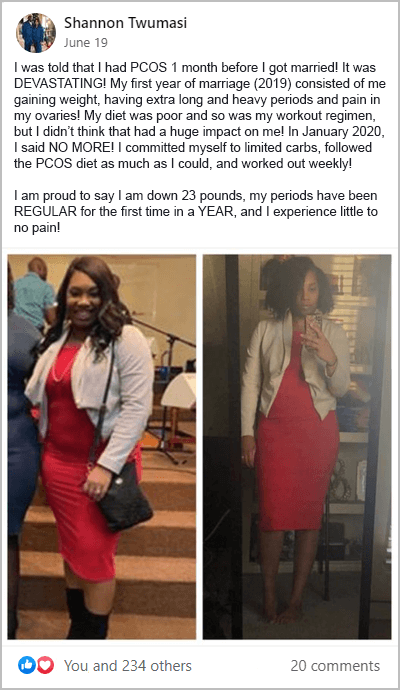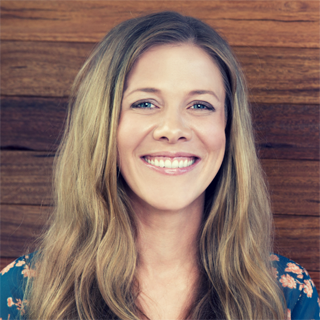If you’re confused about the relationship between PCOS and ovarian cysts, then you’re not alone.
In this article, you’ll learn the key differences between PCOS, and ovarian cysts. To clear the confusion, we’ll also review how polycystic ovaries fit into this picture. The goal is to help you treat and prevent PCOS cyst pain.
The most important take-home is simple. A PCOS diet like the one we follow during my free 30-Day PCOS Diet Challenge is essential for anyone with PCOS. This is especially true for managing ovarian cyst pain.
Difference Between PCOS, Ovarian Cysts, (and Polycystic Ovaries)
Polycystic ovaries are when multiple fluid-filled sacs can be seen on the ovaries. Medical authorities refer to these fluid-filled sacs as “cysts”. But many clinicians argue that the “cysts” seen in polycystic ovaries aren’t actually cysts. They’re follicles that have failed to release an egg during ovulation. They’re a normal part of an ovary. Sometimes it’s normal for women to have a higher number of follicles. Especially young women, as they have more eggs. Having polycystic ovaries doesn’t always mean that there’s something wrong.
Polycystic ovarian syndrome (PCOS) is separate but related to having polycystic ovaries. You can have polycystic ovaries and not have PCOS. You can also have PCOS and not have polycystic ovaries. This is why the name polycystic ovarian syndrome causes a lot of confusion.
PCOS is a hormone disorder with three diagnostic criteria. Irregular or absent periods, elevated androgen levels, and polycystic ovaries. You need two of three factors to be diagnosed with PCOS. This means polycystic ovaries are common among women with PCOS. But you can have PCOS and have normal-looking ovaries too.
Ovarian cysts are different from both PCOS and polycystic ovaries. There are several different types of cysts. Most ovarian cysts cause no symptoms and go away on their own. It’s only when they grow that they begin to hurt. Polycystic ovaries, by comparison, don’t cause pain.
If you have polycystic ovaries and you’re experiencing ovarian pain, it means there’s something else going on. You could have PCOS period pain or PMS. Or you may have an enlarged ovarian cyst. Women with PCOS are more prone to experience painful ovarian cysts. But anyone can have them.
Ovarian Cyst Symptoms
Symptoms of large ovarian cysts include:
- Pelvic pain that may come and go
- Pressure or fullness in your abdomen
- Bloating
- Breast tenderness
- Urinary tract issues
- Pain in the hips and legs
Cysts are most likely to cause pain and cramping mid-cycle. This pain can be sharp or dull and is typically isolated to one side of the abdomen.
When to Worry About Cysts
Most ovarian cysts resolve without treatment. But some complications can be more serious [1].
Torsion is where a large cyst causes the ovary to twist a little. This can obstruct blood flow and often requires medical intervention. Symptoms of ovarian torsion include severe pain in the pelvic area, as well as nausea and vomiting.
Rupture or bleeding of cysts is also very common. This is also known as a hemorrhagic cyst or ruptured cyst. A ruptured cyst is where a cyst bursts open, releasing its contents into your pelvic or abdominal cavity. When a cyst ruptures, you’ll often feel a sharp acute pain, followed by discomfort for a few days after. Other PCOS cyst rupture symptoms include vaginal spotting and abdominal bloating. Medical attention should be sought if you suspect a cyst has ruptured and you also experience a fever. This may indicate an infection. Heavy vaginal bleeding, faintness, or dizziness are also signs that medical help may be needed.
In the majority of cases, monitoring and pain relief are the standards of care for PCOS cyst rupture. In the absence of heavy bleeding or infection, most ruptured cysts will recover on their own. It’s mostly a matter of getting through the pain phase.
Supplements for Cyst Pain Relief
Over-the-counter pain relief is the most common treatment for PCOS ovarian cyst pain. But there are growing concerns regarding the safety of products like Advil (Neurofen) [2]. Tylenol (Panadol) may also not be as safe as many people believe [3].
Curcumin supplements may be a better alternative. One study compared a proprietary curcumin formulation against Tylenol. They found that a 2-gram dose of the curcumin product, Meriva, was comparable to two Tylenol extra-strength tablets [4]. Many other studies have shown that curcuminoids can deliver better pain relief than drugs like Advil [5-7].
Bromelain extracted from pineapples also has serious scientific credibility. This compound is as good as anti-inflammatory drugs for lowering inflammation [8]. It also has fewer side effects.
Many argue that CBD products may be more suitable than OTC anti-inflammatories. Further research is currently underway to further explore this question [9].
For other innovative pain-relief tools, see my PCOS pain article.
How to Prevent PCOS Ovarian Cyst Pain
Like all types of PCOS pain, the best way to treat PCOS ovarian cyst pain is to avoid getting it in the first place. And the best way to avoid it is to treat the underlying causes of PCOS.
All PCOS symptoms stem from elevated androgens, insulin resistance, and chronic inflammation [10-15]. This includes irregular periods, weight gain, hirsutism, acne, and hair loss. Common PCOS co-morbidities like anxiety and depression are pro-inflammatory states [16-18]. And so is ovarian pain caused by enlarged cysts.
The underlying mechanisms of PCOS are linked to gut health and diet [19-21]. This explains why a PCOS diet is so effective at relieving symptoms.
Many women see improvements in symptoms within a few weeks of joining my free 30-Day PCOS Diet Challenge.
Like all things medical, prevention of PCOS cyst pain is better than a cure.
The Bottom Line
Polycystic ovaries, PCOS, and ovarian cysts are different, but related problems. Polycystic ovaries don’t cause pain. But women with PCOS are more likely to experience enlarged cysts which can hurt.
Most ovarian cysts go away on their own. Often pain relief is all that’s needed. Even most cases of ruptured cysts will recover on their own. It’s only when complications like infection or torsion arise that medical intervention is needed.
For women with PCOS, diet and lifestyle interventions should always be a priority. Especially if they experience PCOS ovarian cyst pain. A PCOS diet treats the underlying causes of PCOS and this reduces the likelihood of painful cysts forming.
FAQ
What’s the link between a cyst on ovary and weight gain? According to the Cleveland Clinic, some ovarian cysts can secrete hormones that promote weight gain.
With PCOS, can you feel the cysts? No. Polycystic ovaries are not cysts. They’re follicles or eggs that are normal for the ovaries. They don’t cause pain and you can’t feel them. Pain only occurs when an enlarged cyst forms. It’s something that can affect non-PCOS women too.
Do PCOS cysts hurt? Enlarged ovarian cysts can hurt. They can cause pelvic pain that comes and goes. If a cyst bursts or ruptures, the pain can be sharp and intense. In most cases, pain relief is all that’s needed until the ruptured cyst resolves on its own.
What are PCOS cyst rupture symptoms? You’ll often feel a sharp pain when a cyst bursts. The discomfort may persist for a few days after. Other symptoms include vaginal spotting and abdominal bloating. If you experience a fever following a cyst bursting, you should seek medical attention.
Does birth control help? Yes. Some providers prescribe birth control pills to help shrink an ovarian cyst. Caution is warranted when using birth control as a long-term treatment though. See my PCOS birth control article for more information.
Is PCOS cyst removal possible? Yes. This may be advised for large or persistent ovarian cysts that are causing issues. Cyst removal is performed either by laparoscopy or laparotomy.
Can you take inositol for ovarian cysts? There is strong evidence supporting inositol supplementation for women with PCOS. Products like Ovasitol have a positive impact on ovarian function. This may make painful ovarian cysts less likely.
What is the typical PCOS cyst size? PCOS follicular cysts are normally around 8 mm (0.3 “) in size.
Will taking cinnamon for ovarian cysts help? Cinnamon is one of many herbs that can improve hormone balance in women with PCOS [22-24]. The strength of the effect is likely to be small though.
Intermittent fasting and ovarian cysts. A help or a hindrance? There’s compelling evidence supporting intermittent fasting for PCOS. Fasting may further enhance the benefits of a PCOS diet and may help prevent large ovarian cysts.
Do I need to worry about a nabothian cyst and PCOS? A Nabothian cyst is a mucus-filled lump on the surface of the cervix. No treatment is necessary as they do not cause health problems.
Do I need to worry about a Bartholin cyst PCOS? A Bartholin’s cyst or abscess is a common issue that can affect women with PCOS. Treatment depends on the size and pain experienced. Home treatment is often all that’s needed. But surgical drainage is also common. If an infection occurs, then antibiotics may be prescribed.
Author
As a Nutritionist, I’m continuing my mission to help women like you, beat PCOS. Evidence-based diet and lifestyle interventions helped me overcome five years of infertility. I fell pregnant naturally after multiple failed IVF cycles. Along the way, my other PCOS symptoms went away too. This experience taught me how to combine the latest science with a pragmatic approach to habit change. I’ve now helped thousands of other women achieve life-changing results, and I love for you to be the next PCOS success story. Learn more about me and what I do here.
References
1Mobeen, S. and R. Apostol, Ovarian Cyst, in StatPearls. 2022, StatPearls Publishing
Copyright © 2022, StatPearls Publishing LLC.: Treasure Island (FL).
2Minhas, D., A. Nidhaan, and M.E. Husni, Recommendations for the Use of Nonsteroidal Anti-inflammatory Drugs and Cardiovascular Disease Risk: Decades Later, Any New Lessons Learned? Rheum Dis Clin North Am, 2023. 49(1): p. 179-191.
3Ishitsuka, Y., Y. Kondo, and D. Kadowaki, Toxicological Property of Acetaminophen: The Dark Side of a Safe Antipyretic/Analgesic Drug? Biol Pharm Bull, 2020. 43(2): p. 195-206.
4Di Pierro, F., et al., Comparative evaluation of the pain-relieving properties of a lecithinized formulation of curcumin (Meriva(®)), nimesulide, and acetaminophen. J Pain Res, 2013. 6: p. 201-5.
5Hsiao, A.F., et al., The efficacy of high- and low-dose curcumin in knee osteoarthritis: A systematic review and meta-analysis. Complement Ther Med, 2021. 63: p. 102775.
6Paultre, K., et al., Therapeutic effects of turmeric or curcumin extract on pain and function for individuals with knee osteoarthritis: a systematic review. BMJ Open Sport Exerc Med, 2021. 7(1): p. e000935.
7Maroon, J.C., J.W. Bost, and A. Maroon, Natural anti-inflammatory agents for pain relief. Surg Neurol Int, 2010. 1: p. 80.
8Muhammad, Z.A. and T. Ahmad, Therapeutic uses of pineapple-extracted bromelain in surgical care – A review. J Pak Med Assoc, 2017. 67(1): p. 121-125.
9Mohan, H., et al., Efficacy of Cannabidiol Versus Ibuprofen in the Relief of Menstrual Pain in Females Living with Primary Dysmenorrhea: A phase II, Non-Inferiority trial. Principles and Practice of Clinical Research, 2022. 8(3): p. 68 – 76.
10Wang, J., et al., Hyperandrogenemia and insulin resistance: The chief culprit of polycystic ovary syndrome. Life Sciences, 2019. 236.
11Aboeldalyl, S., et al., The Role of Chronic Inflammation in Polycystic Ovarian Syndrome-A Systematic Review and Meta-Analysis. Int J Mol Sci, 2021. 22(5).
12Dimitriadis, G.K., I. Kyrou, and H.S. Randeva, Polycystic Ovary Syndrome as a Proinflammatory State: The Role of Adipokines. Curr Pharm Des, 2016. 22(36): p. 5535-5546.
13González, F., Inflammation in Polycystic Ovary Syndrome: underpinning of insulin resistance and ovarian dysfunction. Steroids, 2012. 77(4): p. 300-5.
14Popovic, M., G. Sartorius, and M. Christ-Crain, Chronic low-grade inflammation in polycystic ovary syndrome: is there a (patho)-physiological role for interleukin-1? Seminars in Immunopathology, 2019. 41(4): p. 447-459.
15Rudnicka, E., et al., Chronic Low Grade Inflammation in Pathogenesis of PCOS. Int J Mol Sci, 2021. 22(7).
16Beurel, E., M. Toups, and C.B. Nemeroff, The Bidirectional Relationship of Depression and Inflammation: Double Trouble. Neuron, 2020. 107(2): p. 234-256.
17Milaneschi, Y., et al., Association of inflammation with depression and anxiety: evidence for symptom-specificity and potential causality from UK Biobank and NESDA cohorts. Mol Psychiatry, 2021. 26(12): p. 7393-7402.
18Peirce, J.M. and K. Alviña, The role of inflammation and the gut microbiome in depression and anxiety. J Neurosci Res, 2019. 97(10): p. 1223-1241.
19He, F.F. and Y.M. Li, Role of gut microbiota in the development of insulin resistance and the mechanism underlying polycystic ovary syndrome: a review. J Ovarian Res, 2020. 13(1): p. 73.
20Li, G., et al., Alterations of Gut Microbiome and Fecal Fatty Acids in Patients With Polycystic Ovary Syndrome in Central China. Front Microbiol, 2022. 13: p. 911992.
21Tremellen, K. and K. Pearce, Dysbiosis of Gut Microbiota (DOGMA)–a novel theory for the development of Polycystic Ovarian Syndrome. Med Hypotheses, 2012. 79(1): p. 104-12.
22Ashkar, F., et al., The Role of medicinal herbs in treatment of insulin resistance in patients with Polycystic Ovary Syndrome: A literature review. Biomol Concepts, 2020. 11(1): p. 57-75.
23Dou, L., et al., The effect of cinnamon on polycystic ovary syndrome in a mouse model. Reprod Biol Endocrinol, 2018. 16(1): p. 99.
24Moini Jazani, A., et al., A comprehensive review of clinical studies with herbal medicine on polycystic ovary syndrome (PCOS). Daru, 2019. 27(2): p. 863-877.
As a Nutritionist, I’m continuing my mission to help women like you, beat PCOS. Evidence-based diet and lifestyle interventions helped me overcome five years of infertility. I fell pregnant naturally after multiple failed IVF cycles. Along the way, my other PCOS symptoms went away too. This experience taught me how to combine the latest science with a pragmatic approach to habit change. I’ve now helped thousands of other women achieve life-changing results, and I love for you to be the next PCOS success story. Learn more about me and what I do here.





